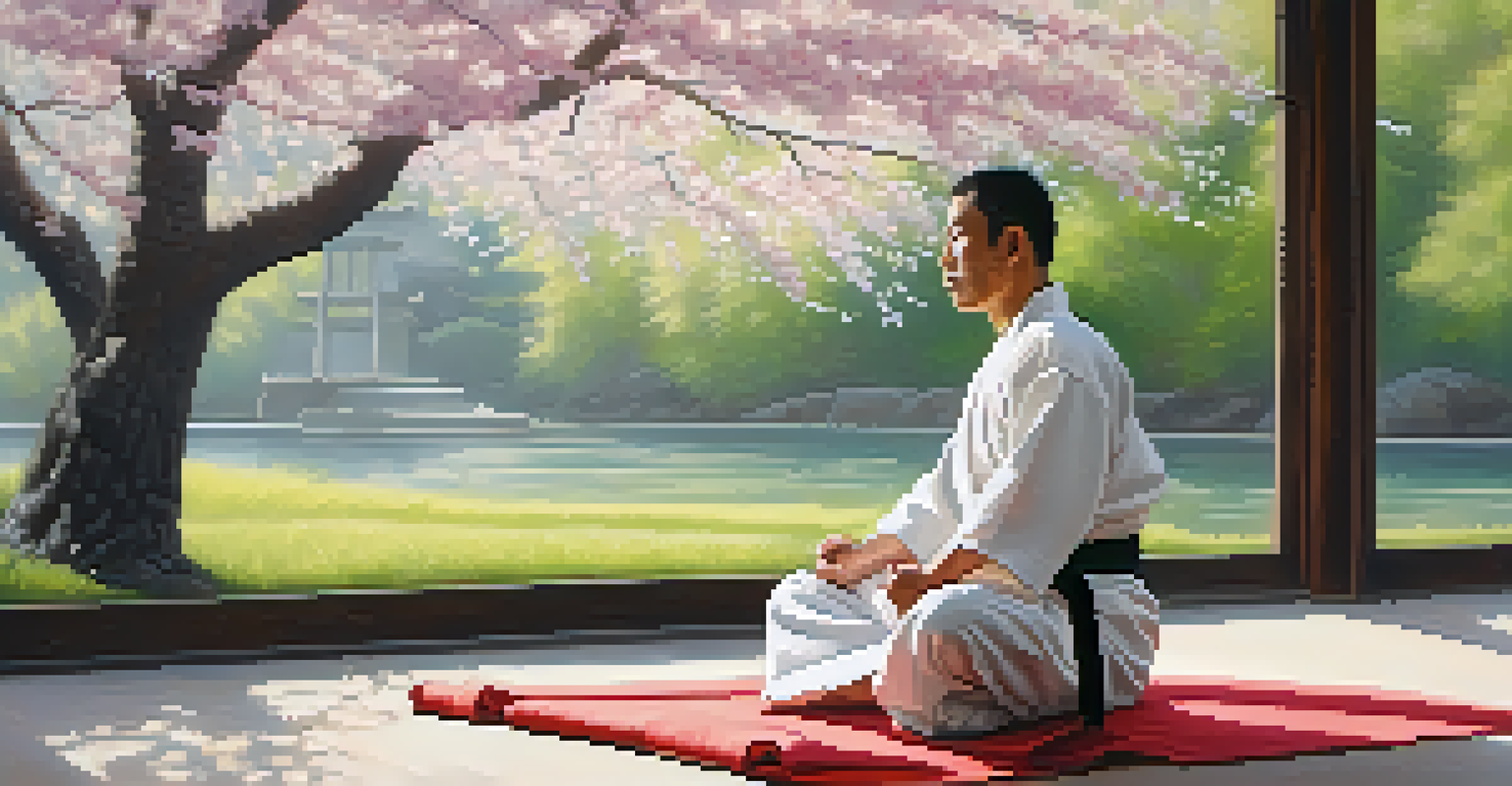Using Conflict Resolution Techniques from Martial Arts

Understanding Conflict Resolution in Martial Arts
Conflict resolution is a fundamental aspect of martial arts training, where practitioners learn to navigate physical and emotional confrontations. At its core, martial arts teaches the importance of balance, control, and understanding one’s opponent. This foundational knowledge can be applied beyond the dojo, helping individuals manage and resolve conflicts in everyday life. Just as a martial artist learns to read their opponent's movements, we can learn to recognize the dynamics of our interpersonal conflicts.
The greatest victory is that which requires no battle.
For instance, in Brazilian Jiu-Jitsu, practitioners focus on leverage and technique rather than brute strength. This approach highlights the importance of strategy over aggression, a principle that can be invaluable in resolving disputes. By understanding the underlying motivations of all parties involved, we can find common ground and work towards a resolution that satisfies everyone. This mindset shift from confrontation to collaboration is a powerful tool in any conflict situation.
Moreover, martial arts training emphasizes self-discipline and emotional regulation. Practitioners are taught to remain calm under pressure, which is crucial during conflicts that can escalate quickly. By mastering one’s emotions, individuals are better equipped to handle disputes thoughtfully and effectively, rather than reacting impulsively. This level-headedness can often be the difference between a heated argument and a constructive conversation.
The Importance of Active Listening in Conflict Resolution
Active listening is a key technique in both martial arts and conflict resolution. In martial arts, a fighter must pay close attention to the opponent's movements and intentions. Similarly, in resolving conflicts, truly hearing what the other person is saying can lead to a deeper understanding of their perspective. This attentive engagement creates a space where both parties feel valued and respected, which is essential for productive dialogue.

An example of this can be seen in the practice of Aikido, which emphasizes blending with an opponent's energy rather than opposing it. When we acknowledge and validate the other person's feelings, it diffuses tension and opens the door to cooperation. Active listening not only helps to de-escalate conflicts but also fosters a sense of empathy between parties, helping to build bridges instead of walls.
Conflict Resolution and Self-Discipline
Martial arts training emphasizes the importance of self-discipline and emotional regulation, which are crucial for effectively managing conflicts.
Furthermore, active listening encourages questions and clarifications, which can lead to uncovering the root cause of the conflict. By asking open-ended questions, individuals can explore the situation more thoroughly. This approach mirrors the martial artist's inquiry into their own techniques and strategies, allowing for a more nuanced understanding of both the conflict and the individuals involved.
Embracing Flexibility and Adaptability in Conflicts
Flexibility and adaptability are vital traits fostered in martial arts, particularly in disciplines like Taekwondo and Kung Fu. Just as a martial artist must adjust their tactics based on their opponent's movements, we too must be willing to pivot our approach when navigating conflicts. This mindset allows for creative solutions that might not be immediately obvious, paving the way for resolutions that are beneficial for all parties.
In the middle of difficulty lies opportunity.
In real-life conflicts, rigidity can often lead to deadlocks. However, by embracing a more fluid approach, individuals can explore alternative viewpoints and solutions. For instance, during negotiations, being open to modifying one’s stance can lead to a win-win situation. It’s akin to a martial artist who, instead of forcing a move, flows with the opponent’s energy to find an opening.
Moreover, adaptability encourages personal growth. Each conflict presents an opportunity to learn more about ourselves and others. By reflecting on our responses and adjusting our strategies, we can improve our conflict resolution skills over time, just as a martial artist hones their technique through practice and experience.
Utilizing Non-Verbal Communication Techniques
Non-verbal communication plays a crucial role in martial arts, where body language can convey strength, confidence, or submission without a single word. This principle is equally important in conflict resolution. Being aware of one’s own non-verbal cues, as well as those of others, can significantly influence the outcome of a conversation. A calm demeanor or open posture can help create a more conducive environment for dialogue.
For example, in a tense discussion, crossing your arms or avoiding eye contact can signal defensiveness or disinterest. Instead, adopting an open posture and maintaining eye contact can foster trust and encourage openness. Just as a martial artist uses their stance to convey readiness or relaxation, we can use our body language to facilitate a more constructive atmosphere during conflicts.
Active Listening Builds Understanding
Active listening in conflict situations fosters empathy and cooperation, leading to more productive resolutions.
Additionally, mirroring the body language of the other person can create a sense of rapport. This technique, often seen in martial arts training, can help to ease tensions and encourage a more collaborative approach. By being attuned to non-verbal signals, individuals can navigate conflicts with greater awareness, ultimately leading to more effective resolution.
The Role of Breathing Techniques in Managing Conflict
Breathing techniques are a cornerstone of many martial arts, helping practitioners maintain focus and calm during intense situations. These techniques can also be incredibly beneficial in managing conflicts. When tensions rise, taking a moment to pause and breathe deeply can help individuals regain their composure and think more clearly. It’s a simple yet powerful tool that can prevent rash decisions and facilitate more thoughtful responses.
For instance, martial artists often practice controlled breathing to enhance their performance and mental clarity. By applying this practice in conflict situations, individuals can create a buffer between their emotions and their reactions. This moment of mindfulness allows for a more measured approach to resolving the issue at hand, rather than reacting impulsively out of frustration or anger.
Moreover, breathing exercises can also model calmness for others involved in the conflict. When one person demonstrates control over their emotions, it can have a calming effect on the entire interaction. This ripple effect can transform a heated argument into a more peaceful negotiation, showcasing the power of mindfulness derived from martial arts practices.
Setting Boundaries: A Key Conflict Resolution Skill
Setting boundaries is an essential skill in both martial arts and conflict resolution. In martial arts, practitioners learn to recognize their limits and the importance of protecting their personal space. Similarly, establishing clear boundaries in conflicts helps to define acceptable behavior and communication. This clarity can prevent misunderstandings and ensure that all parties feel safe and respected during discussions.
For example, in a negotiation, clearly articulating what is and isn’t acceptable can guide the conversation towards a more productive outcome. It’s akin to a martial artist who maintains their stance and ensures they don’t overextend themselves, protecting their position. By reinforcing boundaries, individuals can foster a respectful environment that encourages open dialogue without fear of aggression or manipulation.
Setting Boundaries for Respect
Establishing clear boundaries in conflicts ensures that all parties feel safe and respected, paving the way for open dialogue.
Additionally, setting boundaries allows for self-care during conflicts. It’s important for individuals to recognize when a discussion is becoming too heated or unproductive. Just as a martial artist knows when to disengage from a fight, individuals should feel empowered to step back if necessary. This practice not only protects one’s well-being but also maintains the integrity of the resolution process.
Building Resilience Through Conflict Resolution Practices
Conflict resolution is a skill that, much like martial arts, requires practice and resilience. Each encounter provides an opportunity to learn and grow, building our ability to handle future conflicts with greater ease. Embracing this mindset can transform our perspective on conflicts, viewing them not as obstacles but as chances to develop our conflict resolution abilities.
In martial arts, resilience is cultivated through repeated practice and facing challenges head-on. This principle applies to conflict resolution as well; the more we engage in constructive conversations, the more confident we become in our abilities. Each successful resolution reinforces our skills, making us better equipped to handle the next challenge that arises.

Moreover, building resilience fosters a sense of empowerment. When individuals learn to navigate conflicts effectively, they gain confidence in their ability to influence outcomes and advocate for themselves. This empowerment is similar to a martial artist who grows stronger and more skilled with each practice session, ultimately leading to a more peaceful and fulfilling interpersonal experience.